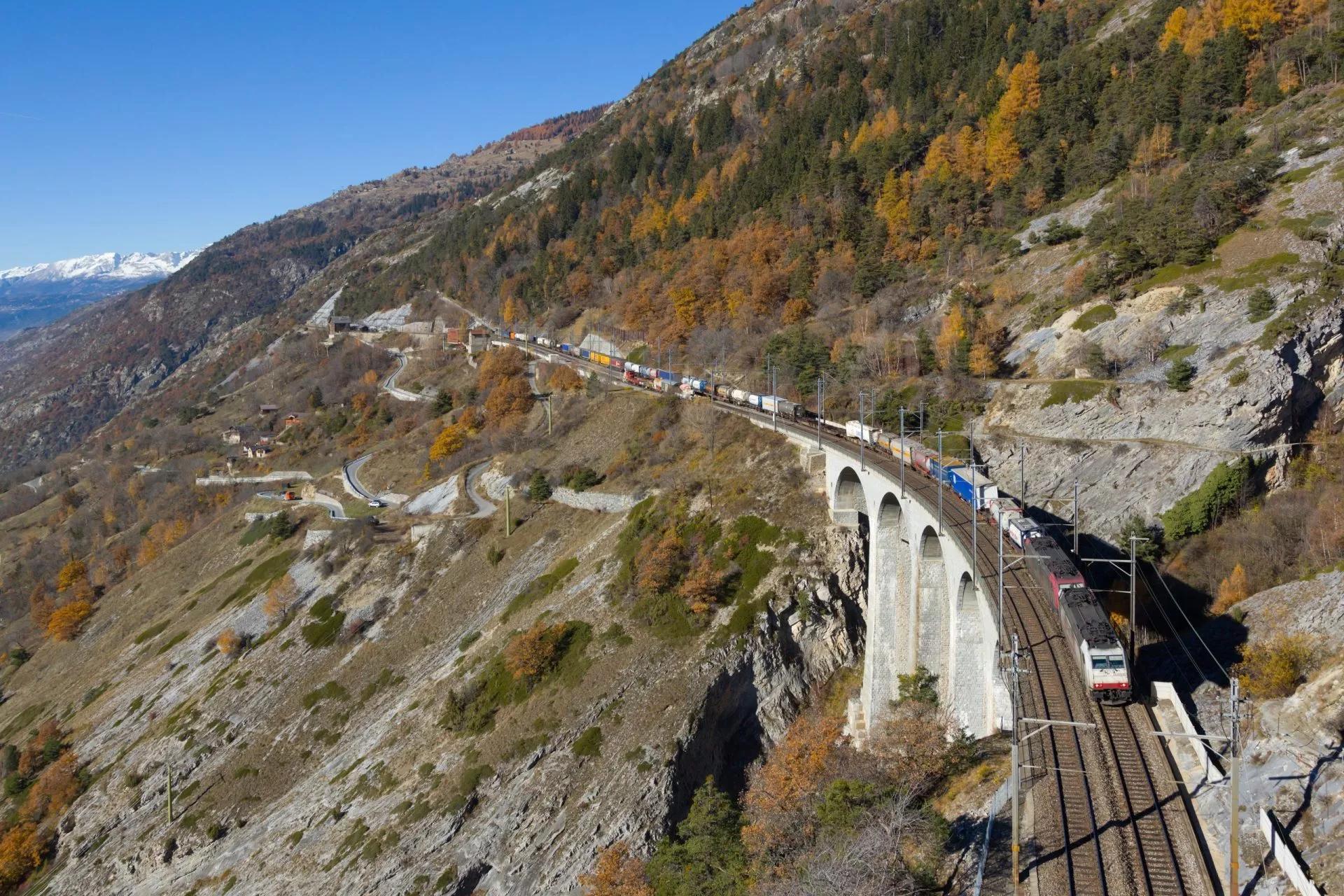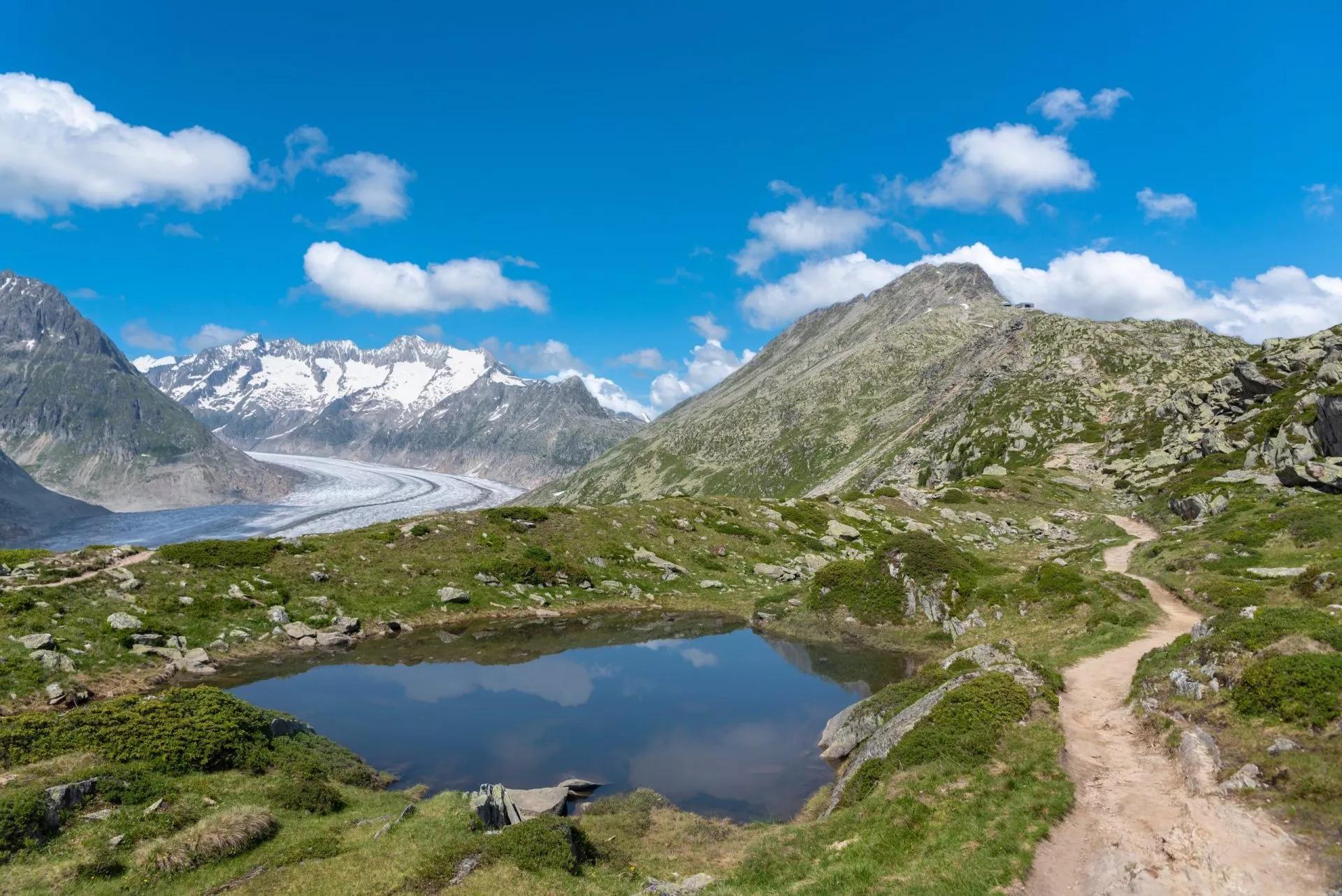11 km and 700 m of elevation gain / 850 m of elevation loss














Aletsch Glacier Panorama Trail
4 days / 3 nights
|
Starting point
Brig
Finish point
Fiesch
Season
From June to September
Technical level
2/5
Fitness level
2/5
Tour type
Inn-to-Inn
Starting point
Brig
Finish point
Fiesch
Season
From June to September
Technical level
2/5
Fitness level
2/5
Tour type
Inn-to-Inn
Highlights
- Discover the longest glacier in the Alps up close
- Explore the car-free mountain villages like Riederalp and Fiescheralp
- Cross the legendary Aletsch Forest with historic trees over 900 years old
- Relax after a day of hiking with delicious Swiss cuisine and Valais wine
- Hike along the panoramic trail with an incredible view of the glacier and the highest Swiss peaks
- Enjoy the sunrise views over 4,000 m peaks from your hotel balcony
Itinerary of the trip
FREE ITINERARY
Get Your Travel Itinerary
Loved the itinerary? Enter your email below, and we'll send a copy straight to your inbox.
What’s included in the price?
Self-guided
NOT INCLUDED
OPTIONAL EXTRAS
What to bring to the tour
- Hiking shoes/boots
- 25 to 45-liter backpack
- Base layer
- Sports T-shirts
- Hiking shorts
- Hiking water-repellent pants
- Waterproof jacket
- Midlayer
- Sports socks and underwear
- Leisurewear for evenings
- Down jacket
- Gloves
- Shade hat/cap
- Warm headwear
- Sunscreen
- Sunglasses
- Headlamp
- Hiking poles
- ID card or passport
- Snacks
- Cash
- Water bottles or hydration pack
- Sleeping liner
- Toiletries
- Toilet paper
- Small first aid kit
Looking for a high-alpine adventure that’s breathtaking but accessible?
The Aletsch Glacier Panorama Trail is perfect for active hikers who want big mountain views without technical climbing. If you love panoramic trails, remote villages, and hiking at your own pace—this 3-day glacier trek is for you.
Here, you don’t just see the Alps—you walk beside their beating heart. The Aletsch Glacier, at 23 kilometers, is the largest glacier in the Alps. Towering ice, ancient forests, and the silence of altitude combine into something truly extraordinary. This is a chance to witness a vanishing wonder—before it’s gone.
Each day places you on a natural balcony, high above the world, with the glacier to one side and 4,000-meter peaks to the other.
The trail leads you through the Aletsch Forest, home to some of the oldest trees in Switzerland—gnarled, wind-sculpted Swiss stone pines that have stood for over 900 years. Surrounded by silence, glacier views, and the scent of alpine pine, the atmosphere is nothing short of magica
Add in panoramic ridge walks, shimmering glacial lakes, the surreal glow of the Tälligrat tunnel, and the thrill of crossing a 160-meter suspension bridge—and you have a journey that’s rich in drama and beauty from start to finish.ht.
We take care of all the details so you can focus on enjoying your adventure. We book the accommodations and provide a detailed itinerary booklet, GPS routes, and 24/7 support. Our goal is to make your hike as stress-free and enjoyable as possible.
This is more than a hike—it’s a rare chance to walk beside a frozen giant, through a landscape shaped by time.
Frequently Asked Questions
Ratings & Reviews

5.0 average rating

The Tour du Mont Blanc was easily one of the most memorable trips I’ve taken in years. From breathtaking views and warm, welcoming people to delicious food and charming mountain huts, every aspect of the journey was unforgettable. The hikes were significantly more challenging than I had anticipated, but the reward was well worth the effort. I can’t overstate how much smoother and more stress-free the experience was thanks to Hut to Hut’s incredibly detailed guides. Having accommodations pre-booked, access to a well-designed GPS trail map, and a comprehensive guide outlining what to expect, what to pack, and what to watch out for made all the difference. If you’re considering hiking the TMB, I wholeheartedly recommend booking with Hut to Hut. Their support turned a great adventure into an exceptional one.


Samo and Eva did a wonderful job in organizing my six-day Slovenian Mountain Trail hike. From the first contact to the delivery of the package with hike details, hut reservations, GPX etc. was efficient. I had a wonderful challenging hike as a solo self-guided hiker. Samo was supportive to the extent possible for my challenging day #4 from Aljazev Hut to Dolicu Hut in very bad weather. All arrangements worked perfectly. Highly recommend them if you want to take the difficulty out of the organization itself and simply enjoy the hiking expereince.


Incredibly route through the Karavank & Julien ranges. Huts were rustic & scenic and all check-ins were smooth. The route guides that Hut-to-Hut provided were extremely helpful, available offline & gave us peace of mind while traveling through new territory. Highly recommend.


Great Trip, Great Company! Nina and her team handled every detail flawlessly. We had originally planned to join a guided group tour, but choosing the flexibility of sleeping in and setting our own pace turned out to be the best decision—and the savings let us upgrade our hotels. The bag-transfer service was seamless from start to finish. I highly recommend them!


We did the five day/four night highlight tour and it was breathtaking! The Tours Du Mont Blanc team was very accommodating of our request for private rooms on the hike (when available) and also with last minute logistics due to the Mount Blanc tunnel closure. Samo and Nina were very responsive and answered all of our many questions :).


Samo and Eva did a wonderful job in organizing my six-day Slovenian Mountain Trail hike. From the first contact to the delivery of the package with hike details, hut reservations, GPX etc. was efficient. I had a wonderful challenging hike as a solo self-guided hiker. Samo was supportive to the extent possible for my challenging day #4 from Aljazev Hut to Dolicu Hut in very bad weather. All arrangements worked perfectly. Highly recommend them if you want to take the difficulty out of the organization itself and simply enjoy the hiking expereince.


Great Trip, Great Company! Nina and her team handled every detail flawlessly. We had originally planned to join a guided group tour, but choosing the flexibility of sleeping in and setting our own pace turned out to be the best decision—and the savings let us upgrade our hotels. The bag-transfer service was seamless from start to finish. I highly recommend them!


The Tour du Mont Blanc was easily one of the most memorable trips I’ve taken in years. From breathtaking views and warm, welcoming people to delicious food and charming mountain huts, every aspect of the journey was unforgettable. The hikes were significantly more challenging than I had anticipated, but the reward was well worth the effort. I can’t overstate how much smoother and more stress-free the experience was thanks to Hut to Hut’s incredibly detailed guides. Having accommodations pre-booked, access to a well-designed GPS trail map, and a comprehensive guide outlining what to expect, what to pack, and what to watch out for made all the difference. If you’re considering hiking the TMB, I wholeheartedly recommend booking with Hut to Hut. Their support turned a great adventure into an exceptional one.


Incredibly route through the Karavank & Julien ranges. Huts were rustic & scenic and all check-ins were smooth. The route guides that Hut-to-Hut provided were extremely helpful, available offline & gave us peace of mind while traveling through new territory. Highly recommend.


We did the five day/four night highlight tour and it was breathtaking! The Tours Du Mont Blanc team was very accommodating of our request for private rooms on the hike (when available) and also with last minute logistics due to the Mount Blanc tunnel closure. Samo and Nina were very responsive and answered all of our many questions :).


All available guidance options
Self-guided
Are you looking for a good adventure and limitless flexibility? Then you should try out a self-guided tour, perfect for independent explorers who want to set their own pace. Without the need to stick to a group schedule, you’re free to linger at scenic viewpoints while the logistics are taken care of in advance.

Hassle-Free
We handle itineraries, accommodations, and anything else you prefer not to deal with, so you can enjoy a carefree hike.

Book with confidence
We are a financially protected company, fully bonded and insured, keeping your money safe and allowing you to travel with confidence.

Tried & Tested Adventures
Only the best hut to hut hikes of Switzerland, cherry-picked by our local team with an in-depth knowledge of the region.

Unbeatable support
Our 24/7 customer support is where we show our passion, bringing you a better experience by making your well-being our number one priority.




























